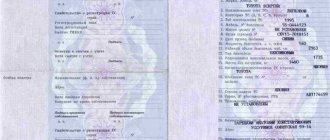Today, for many families with children, the issue of disposing of funds under the state certificate for maternity capital, provided for by law dated December 29, 2006 No. 256-FZ, remains relevant.
According to official data from the Russian Pension Fund at the end of 2016, of the 7.3 million families that received the right to maternity capital since January 1, 2007, about 50% have never submitted an application to the Pension Fund to spend funds in areas already provided for by law.
Anti-crisis measures taken in the social sphere in 2009, 2010 and 2020 showed what people need most:
- one-time payments from maternity capital funds in the amount of 12 thousand rubles in 2009 and 2010 were issued by more than 1 million 600 thousand families, or 68% of all certificate holders;
- in the main areas (improving housing conditions, education for children and the formation of the funded part of the labor pension) in 2010, only 17.7 thousand applications were submitted, or 0.7% of their total number.
Such data was cited by Elena Mizulina (then the head of the State Duma Committee on Family, Women and Children, and currently a Member of the Federation Council in the Russian Parliament) in 2011 during the discussion of bill No. 302723-5 on the possibility of using maternal capital funds for the purchase family of a new domestic car . However, then this draft law was rejected as not taking into account the interests of children .
In addition, in 2015-2016. 2 million families applied for a one-time payment of 20 thousand rubles , receiving money totaling about 40 billion rubles.
In fact, the statistics presented indicate that families with two or more children are in great need of material support, but cannot satisfy their needs by directing maternity capital to options already provided for by law. In this regard, it is necessary to expand the list of possibilities for managing funds under the state family subsidy.
The discussion on the possibility of disposing of maternity capital funds for the purchase of a car flared up with renewed vigor at the end of 2014, when Dmitry Medvedev instructed the Cabinet of Ministers to work on this issue by February 12, 2020, but a decision in this regard was never made. The auto industry was then left without support for maternal capital certificates.
On January 25, 2020, in connection with the intensifying crisis in the country's economy and the development of a new anti-crisis plan, deputy from the Communist Party of the Russian Federation Vadim Solovyov sent a request to the Prime Minister with another request to allow the use of maternity capital to purchase a car produced in Russia.
Features of the new bill
December 2014 was marked by an order given by the Prime Minister to the Government of the Russian Federation. Its essence was that before February 12, 2020, the Cabinet of Ministers should consider the issue of creating a real opportunity for citizens to purchase a car for maternity capital. Such a step was called a condition for the development of the domestic automobile industry.
The matter did not reach a serious change in the situation either in 2020 or in 2020, when a bill was even introduced into the State Duma that proposed amendments to Federal Law No. 256 of December 29, 2006. To date, no law has been adopted allowing the use of maternity capital to purchase a car.
The legislation directly indicates several ways to develop maternal capital:
- children's education;
- purchase or reconstruction of housing for a family;
- mother's pension;
- social adaptation of children with disabilities.
The above-mentioned bill contains a number of conditions under which it becomes possible to buy a car with maternity capital. Money for the purchase must be transferred to the seller only in cashless form. It is possible to obtain the certificate before the youngest child reaches 3 years of age. The car itself must be:
- made in Russia;
- a completely new car (purchase of a used car is not allowed);
- suitable for a large family in terms of the number of seats, but there should be no more than 8.
It is also proposed to limit the possibility of resale of the car by making it:
- not available for resale for the first 3 years after purchase;
- necessarily divided into shares.
The latter establishment may lead to a situation where parents who are unable to agree on the procedure for using the vehicle will be forced to resort to court proceedings on this issue. In resolving such a dispute, the magistrate will first of all take into account the interests of the children. Each parent will be allocated their own days to travel in the family car.

History of legislative initiatives on the use of maternal capital for the purchase of a car
It should be noted that this topic has been used in the political struggle among Duma parties since 2009. It affects a large part of the active electorate, and therefore is quite actively exploited to attract public attention:
- The first such bill was submitted to the State Duma in August 2009. However, the initiators violated Part 3 of Art. 104 of the Constitution of the Russian Federation. They did not attach the Government's opinion on this issue to the draft.
- Already in December of the same year, a new bill was registered (No. 302723-5). Its essence was to amend the legislation to allow the purchase of domestically produced cars for capital. The government did not support the document. His arguments concerned the impossibility of registering property for the entire family (parents and minors). This could infringe on the rights of one of the parties. As a result, the draft was rejected in the first reading in February 2011.
- The next attempt to allow the insertion of a certificate into vehicles occurred in August 2014. On the 5th, bill No. 583192-6 was registered. He didn't even make it to the first hearing. The document was “rejected” at the stage of preliminary study, as not meeting constitutional requirements, as well as State Duma regulations.
Attention! At the end of 2014, the Chairman of the Government of the Russian Federation, by his instructions, proposed to the Cabinet of Ministers to develop the conditions for using the certificate for the purchase of a car. The deadline for execution of the order was 02/12/2015.
The essence of the officials' objections
When developing a program for maternal capital, the purposes of its expenditure had to correspond not only to the interests of citizens, but also to the main directions of the country's development. In general, such harmony was achieved:
- the purchase of housing has an impact on the development of:
- municipal infrastructure;
- banking sector;
- improving the well-being of citizens (long-term investments);
- spending budget funds on education contributes to:
- development of the country's creative potential;
- increasing the cultural and educational level of the people;
- providing sectors of the domestic economy with highly professional personnel;
- investing in mothers’ pensions also provides a certain two-way economic effect:
- older women will have a high level of income;
- this factor reduces the burden on the state Pension Fund.
Attention! Maternity capital, in addition to those indicated, has a deeper goal setting. It is aimed at strengthening the institution of family and traditional values.
What will give the state permission to purchase cars for a certificate?
Using the logic described above, you can see how the adoption of the bill will affect the country as a whole. If you allow the use of a certificate for domestically produced cars, then:
- part of the budget funds will be redirected to the automotive industry;
- citizens will receive short-lived material value;
- part of the funds will be directed to the same banking sector (to secure car loans).
While support for the domestic automobile industry may be part of the state’s goals, it is not at all satisfied with such support for families:
- Cars lose value pretty quickly.
- Their maintenance requires additional funds, which the family will be forced to take away from the children.
- A car is rarely inherited, meaning it is not a capital investment.
- This waste of money does not benefit the infrastructure.
Pros and cons of investing a certificate in a vehicle
There are the following advantages of using maternity capital for a car:
- the opportunity to fully realize maternity capital without attracting additional finance, since its amount will be 475 thousand rubles in 2020, which is quite enough to buy a car;
- the ability to quickly move a family with children in both urban and rural areas;
- support for the domestic automobile industry;
- the opportunity to replenish the family budget by earning money as a private driver.
Critics of this bill cite the following arguments against it:
- rapid depreciation of the car due to wear and tear;
- threat of damage to the car when involved in an accident;
- the possibility of quickly losing a car due to theft;
- the possibility of quick resale of the vehicle, which means actual cashing out of capital;
- A car is not a necessary attribute of a prosperous family, unlike education and housing.

Is it possible to buy a car with a regional certificate?
You can buy a car in a much safer way using a regional certificate if the family lives:
- In the Novosibirsk region. The opportunity is open to those who have a second child and subsequent children born after January 1, 2012.
- In the Kurgan region. They also buy a car at MTK after the birth of their second newborn.
- In the Ulyanovsk region. The conditions are the same as in previous cases, but the child must be born or adopted after 2011.
- In the Kaliningrad region. Money for this purpose is given out only after the third baby.
- In the Kamchatka region. There is also a chance for parents of first-born children.
Implementation of the program in the constituent entities of the Russian Federation
Problems with the implementation of the federal law have led to the development of this issue in the regions. Since 2008, in some regions of the federation it has become possible to spend part of maternity capital on buying a car. Each region determines the amount of such regional capital independently, but usually it ranges from 100 to 150 thousand rubles. There are still few entities practicing this form of support for young families:
- Kaliningrad region;
- Ulyanovsk region;
- Novosibirsk region;
- Smolensk region;
- Kurgan region;
- Kamchatka Krai.
In the latter, the program is notable for the fact that a mother can receive capital amounting to 100 thousand rubles at the age of 19 to 25 years after the birth of her first child. This money can be spent after the child reaches six months. In addition, for the second and subsequent children, regional capital payments are provided in the amount of 300 thousand rubles for each. The only limitation in choosing a car and a seller is the need to purchase only a new car.
Now let’s directly consider the question of how to buy a car.
Choice of seller and car
A family intending to purchase a car using maternity capital must first find a seller who is willing to sell the car for cashless payment.
The state carefully monitors the legality of the use of maternal capital, so the purchase process will take some time (usually from one to two months). Authorized bodies verify the authenticity of the documents involved in the transaction, as well as the status of the seller.
Submission of documents to the Pension Fund of Russia
Holders of maternity capital must submit an application containing a request to purchase a car using maternity capital funds to the Pension Fund. The application must properly justify your choice. The package of documents that must be attached to it is as follows:
- vehicle passport;
- car purchase/sale agreement;
- a bank certificate confirming the presence of debt on the account to which funds are planned to be transferred during the transaction;
- loan agreement (in case there are not enough capital funds and borrowed funds are attracted).
In some constituent entities of the Russian Federation, family inspections are practiced by social protection authorities, which are called upon to assess the living conditions of children. Living space will be assessed primarily. If the inspectors deem them not in need of improvement, then the parents will receive appropriate permission to purchase the car.
Payment and use of the car
Parents become happy owners of a personal car after the money is in the account of the seller or the bank from which the car loan was taken out for this purchase.
In different regions, there are different nuances of purchasing a car using regional capital. The following table will help you understand them.
| The subject of the Russian Federation | Features of regional capital |
| Novosibirsk region | Money can be received if the second and subsequent children were born after January 1, 2012 |
| Kurgan region | Only after the birth of the second child is it possible to buy a car |
| Ulyanovsk region | Purchasing a vehicle is possible if the third and subsequent children were born or adopted after 2011 |
| Kaliningrad region | It will be possible to spend regional capital on a car only after the birth of the third child |
| Kamchatka Krai | It is possible to use regional capital funds to purchase a car after the birth of your first child |
Unfortunately, at the level of the Russian Federation, the issue of purchasing family cars with maternity capital has not yet been resolved. Nevertheless, some regions have taken up the task of supporting citizens in this area, and this opportunity should be used by everyone who is already planning a new addition to the family.
Persons who can buy a car with maternity capital
You are allowed to buy a car using maternity capital under the project:
- the parent of a second child or subsequent ones;
- her authorized representative who has a document drawn up by a notary;
- to the father, if the mother is no longer alive or has been deprived of parental rights;
- adoptive parents of two or more children;
- mother of a disabled child.
You can spend money in this way on a Russian-made vehicle with a capacity of up to 8 people. Moreover, it should not be the third or fourth in the family, maximum second. That is, wealthy parents will not be able to have a whole fleet of vehicles.

You are only allowed to buy a new car; buying a used one would mean breaking the law. Taking a car and immediately selling it to get cash will not work. The equipment must be used for at least 3 years. And only then can you exchange it for money.
And while the car is in the hands of the family, only one member will not be able to use it at the expense of others. This is shared ownership. And if parents are unable to decide who will ride it and when, the court will do everything for them in the interests of the children.
Buying a car with financial capital - the pros and cons
For many Russian families, purchasing a car is a real way to improve their quality of life.
Mobility is especially important for large families living in rural areas or remote areas of the city. Children constantly need to be transported to kindergartens, schools, clinics - without a car, this takes several hours every day.
Arguments for"
We list all the arguments in favor of purchasing a car with state assets:
- the price of a new car made in Russia is quite comparable to the amount of family capital (unlike, for example, the cost of an apartment);
- families who do not have problems with living space do not find it attractive to spend money on education and pension savings: such options are perceived as “deferred needs”, irrelevant given the current difficulties;
- a car saves parents time and money spent on daily travel in urban environments;
- Due to the reduction in suburban railway traffic in recent years, the opportunities for receiving qualified medical care, educational services, and even purchasing necessary goods from residents of the outback are decreasing.
Thus, for many families, a car is an essential necessity, not a luxury item.
Half of all large families in Russia live in rural areas. In cold weather, getting to schools and kindergartens is difficult: parents are forced to leave their children at home so as not to expose them to the danger of hypothermia.
Having your own transport reduces the daily costs of parents' time and money and provides children with more opportunities for learning and development. Weren't these the goals that were originally set for the fertility stimulation program?
Arguments against"
Some officials believe that parents' purchase of a new car will not affect the interests of their children.
They believe that this will only increase the number of maternity capital frauds: certificate holders will purchase cars by bank transfer, in order to then resell them and cash out the funds.
There is a clear underestimation of the interests of ordinary people and the distance of high-ranking officials from the needs of the people. It’s time for officials to stop pitting the goals of children and parents against each other. Any saving of effort and time for moms and dads ultimately has a beneficial effect on children.
The state is called upon to support the family as a social institution and take into account the interests of all its members.
Let us list the arguments of opponents of the “automobilization” of Russian families:
- a car cannot be compared in its importance to an apartment or the prospect of receiving a full-fledged education;
- the older the children are, the greater the need to increase living space (even to the point of purchasing separate housing) - instead, by the time the child grows up, families will only have an old, illiquid car;
- The intended use of a vehicle is more difficult to control than, for example, the use of housing.
Against the backdrop of a decline in car sales in 15-16, this option of using state assets is considered by some officials not as concern for the population, but as lobbying the interests of the auto industry and representatives of the transport sales market.
Results
So, now readers know all the arguments for and against, and they can draw their own conclusions regarding this issue.
Our opinion is that it is necessary to allow the use of maternity capital to purchase a car, since more than half of families still do not know how to use government subsidies with real benefit for the whole family.

In our opinion, having your own transport will have a beneficial effect on both children and their parents.
The car can be used both for everyday needs and for complete family recreation in the summer. Traveling out of town in a personal car is much easier and more pleasant than using rail transport or other means of transportation.
Is it possible to repay a car loan with maternity capital?
If a family lives in a region where it is officially allowed to spend MSC on a car, they may be allowed to repay the car loan with local maternity capital. To do this, you need to have normal housing and other acceptable living conditions for children. The procedure involves submitting a certificate, application and other documents to the Pension Fund and verification by the organization. As soon as it is completed, the money will be transferred to the creditor bank.

Car purchase and sale agreement under a regional certificate
The purchase and sale agreement for a car purchased under a regional certificate is drawn up in the same way as in other cases. An example can be seen here. It is imperative to specify the method of settlement with the salon and that the money comes from maternity capital. They also enter information about the seller, the car, the buyer, and note the latter’s satisfaction with the technical condition of the vehicle.
At the end they put the date of registration and signature. One copy remains in the car dealership, the other is picked up by the buyer. He also submits the DCP to the Pension Fund of the Russian Federation.
Is it possible to buy a garage with maternity capital?
It is also possible to buy a garage using regional maternity capital. Federal benefits cannot be spent on this. And in the first case, registration goes through the Pension Fund, just like if you want to buy a car. If there is a need for a garage, and the children in the family have all the other conditions for normal development, the purchase will be allowed.
We recommend reading about the state car recycling program. From the article you will learn about what the car recycling program is, whether it is suitable for trucks, where and how to return the car. And here is more information about whether everyone can choose a number for a car.
So far, the boundaries of the use of MTK are quite narrow. This includes housing, a pension for the mother, education and treatment for children. It will be possible to buy a car only with one-time regional payments, but they are not available in all regions and regions of the country.
Submission of documents to the PRF
To conclude a transaction, you must present to the Pension Fund:
- applicant's passport;
- previously issued certificate;
- the application for the use of funds;

- PrEP;
- PTS;
- an agreement with the bank, if the cost of the car is more than the amount of capital and another loan is taken out;
- a certificate from there about the debt on the account to which funds should be transferred;
- documents demonstrating the status of the car dealership.
The papers are checked for about a month. If they are in order, the deal will go through. Otherwise, the Pension Fund will not allow it.










